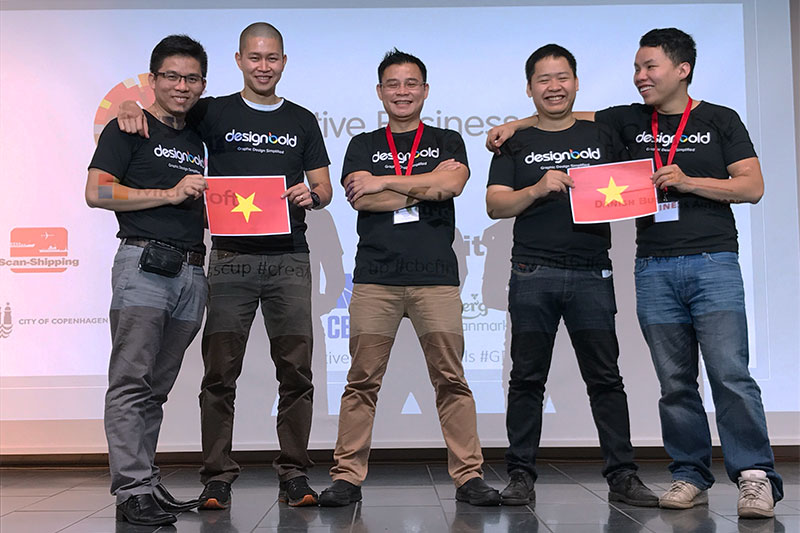We talk with Hung Dinh, founder of Hanoi-based graphic design app DesignBold, about the issues Vietnamese entrepreneurs face finding a global audience, and the best tools to combat them.
Living in Vietnam comes with a constant buzz. From buzz about the latest startup, restaurant or concept store to motorbikes buzzing down tiny alleyways, weaving around the market produce, live fish and fresh flowers, noise, change and a humming atmosphere are impossible to escape. When you’re in it, however, it can be easy to be consumed by that general buzz, forgetting that a wider ecosystem exists and that, in some areas, Vietnam is still finding its place in it.
One sector of that ecosystem the country has yet to fully break into is technology. According to Hung Dinh, a serial entrepreneur with over 15 years of experience in web and mobile business development, its only in the last 6 years that his hometown has really made inroads on the tech scene. As the founder of DesignBold, an online graphic design tool that managed to acquire 35,674 subscribers worldwide within 2 weeks of its launch – he’s well placed to identify the challenges homegrown startups face when attempting to reach beyond Vietnam’s borders.

According to Mr Dinh, Vietnam has a way to go before securing its future as a force in the global tech economy; however, the country’s potential is strong. Look to his growth, and there’s plenty to get excited about. Having come up for the idea for DesignBold on a one-month course in entrepreneurship in Israel, he returned home to launch it in 2016. With a focus on easy to use technology thanks to a drag and drop system, DesignBold offers users simple graphic design tools applicable to everything from social media ads to posters, presentations and more that allow them to design whatever they need without much technological skill. Within a year of launching, one in five of his users were from the United States. Now, the United States and Western Europe make up the company’s most loyal international markets in a showing of global traction not typical of a Vietnamese startup.

Numerous factors have played a role in the changing tech landscape in Vietnam. Big players like Uber and Grab did more than change the way people get from point A to point B, they introduced online payment to a country that still relies primarily on cash transactions. Social media has created a boom in smartphone users, unsurprising in a country where 40% of the population is under the age of 24. The country is also home to an impressive and globally renowned engineering force. “Two or three years ago, the number of startups was very high in Vietnam,” says Mr Dinh. “Over the past few years, however, the quantity has decreased but the quality of the startups is much better. In large part, this is because Vietnam has a huge number of very talented engineers.”
With over 100,000 engineers graduating each year, the country holds a position in the top 10 countries in the world for engineering output, fueling its highly regarded app economy. However, many of these talented individuals are employed by international companies who turn to Vietnam for talented yet comparatively cost-efficient experts. “An engineer in the US may cost $7,000 – $8,000 USD, and for the same or maybe even higher quality in Vietnam, the rate is around $1,500,” says Mr Dinh. “The market is, clearly, quite different. Cost of living plays a large role in this.” And what this means is that, whilst the talent pool within the country is growing, much of their efforts are being outsourced to the global economy.
As Mr Dinh sees it, the two major issues facing startups in Vietnam are a lack of both media coverage and funding. “Vietnam doesn’t have the venture capital startups require to successfully reach international recognition,” he declares. “While the population is over 100 million, the spending power is still low and investors can feel sceptical investing in and exploring opportunities in Vietnam.” And, on top of that, “there isn’t a lot of content published about Vietnamese startups, especially content written in English. These are the two problems we really need to solve in order for companies to reach international levels. We need investments and we need media coverage for people to become aware of the potential of Vietnamese startups.”

All of this isn’t to say it’s not all to play for. “The Vietnamese government has increased media attention for local startups, which is great,” says Mr Dinh. “But there still isn’t a lot of capital support yet. We need policy change faster in order to succeed on a global scale.” Factor in increased interest from international companies in Southeast Asia as they seek refuge from overcrowding and high levels of competition, as well as Vietnam’s very large, very young population emerging with ever more skills and talent, and you’d wager this change is coming soon. “The population is young and the country is still emerging, so there is a lot of opportunity for Vietnam. It’s not mainstream, but it’s becoming more common. Companies are outsourcing to Vietnam and discovering talent. I think we have the best developers in the region. With those things in consideration, I think Vietnam has the potential to become a hub for startups in Southeast Asia.”




